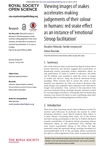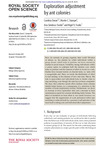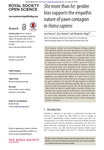Search
Now showing items 1-10 of 23
Viewing images of snakes accelerates making judgements of their colour in humans
(2014)
One of the most prevalent current psychobiological notions about human behaviour and emotion suggests that prioritization of threatening stimuli processing induces deleterious effects on task performance. In order to confirm ...
Teaching in hunter– gatherer infancy
(2016)
A debate exists as to whether teaching is part of human nature and central to understanding culture or whether it is a recent invention of Western, Educated, Industrial, Rich, Democratic cultures. Some social–cultural ...
Receiving of emotional signal of pain from conspecifics in laboratory rats
(2015)
Though recent studies have shown that rodents express emotions with their face, whether emotional expression in rodents has a communicative function between conspecifics is still unclear. Here, we demonstrate the ability ...
Untitled
(2015)
Recent developments in the study of animal cognition and emotion have resulted in the ‘judgement bias’ model of animal welfare. Judgement biases describe the way in which changes in affective state are characterized by ...
Familiar and unfamiliar face recognition in crested macaques
(The Royal Society, 2015)
Many species use facial features to identify conspecifics, which is necessary to navigate a complex social environment. The fundamental mechanisms underlying face processing are starting to be well understood in a variety ...
Emotion recognition deficits in eating disorders are explained by co-occurring alexithymia
(The Royal Society, 2015)
Previous research has yielded inconsistent findings regarding the ability of individuals with eating disorders (EDs) to recognize facial emotion, making the clinical features of this population hard to determine. This study ...
Social dominance modulates eavesdropping in zebrafish
(The Royal Society, 2015)
Group living animals may eavesdrop on signalling interactions between conspecifics and integrate it with their own past social experience in order to optimize the use of relevant information from others. However, little ...
Exploration adjustment by ant colonies
(2016)
How do animals in groups organize their work? Division of labour, i.e. the process by which individuals within a group choose which tasks to perform, has been extensively studied in social insects. Variability among ...
She more than he: gender bias supports the empathic nature of yawn contagion in Homo sapiens
(2016)
Psychological clinical and neurobiological findings endorse that empathic abilities are more developed in women than in men. Because there is growing evidence that yawn contagion is an empathy-based phenomenon, we expect ...
Social familiarity affects Dianamonkey alarm call responses in habitat-specific ways
(2016)
Male Diana monkeys produce loud and acoustically distinct alarm calls to leopards and eagles that propagate over long distances, much beyond the immediate group. Calling is often contagious, with neighbouring males responding ...










